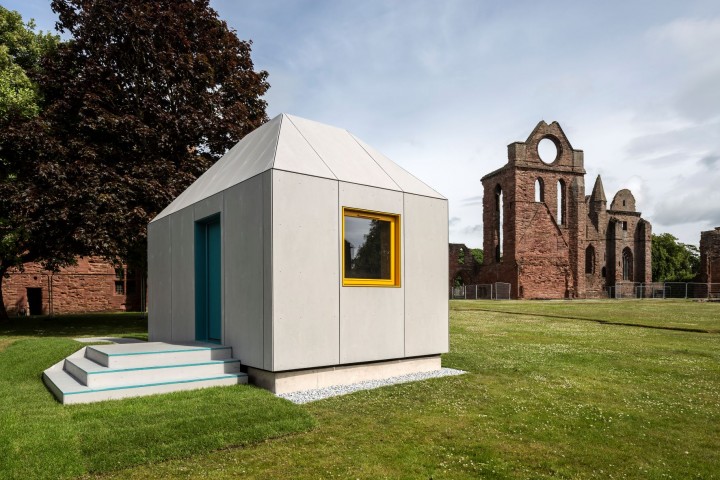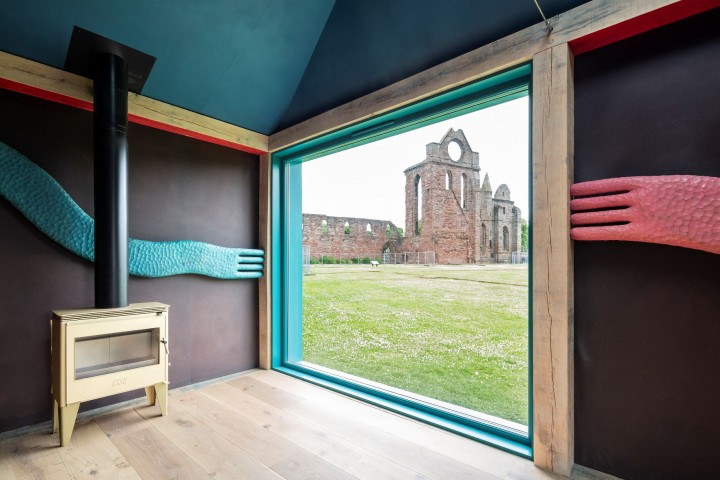Scottish Art News
Latest news
Magazine
News & Press
Publications
The Monks’ Tale
By Greg Thomas, 22.08.2022

Arbroath Abbey has been a site for scholars and scribes since its foundation in 1178, including those who composed the famous Declaration of Arbroath (1320). Now, a residency space on the Abbey grounds fosters a new spirit of storytelling. Greg Thomas scribes.
Ann Craig, Events Organiser at Angus Writers Circle, is telling us the one about the ghostly stone-mason: “I had a friend who worked here and got friendly with the guys who were looking after the building. They were up the scaffolding working one day and the boss, Jim, said ‘knock off for tea, guys’. So they all came down but they could still hear someone up there, tapping and banging. Jim looked up – ‘come on, work’s over’ – and it just carried on. But there was no one up that scaffolding....These are stonemasons, not fanciful types. But after that they all felt there was someone up there helping them.”
“I’m getting shivers!” says Sandra Ireland, the Writing Circle’s Secretary. Sandra, Ann and the group’s president Margaret Bowman are talking to me in Bobby Niven’s ‘New Scriptorium’, a brushed concrete bothy with a gorgeous, squint slanted roof and central skylight, wide windows opening out onto the Abbey grounds, and an interior cradled by brightly coloured sculptural hands. Blue, orangey-red, teal, sinuous and serpentine, they are mottled by the monk-like task of the artist’s whittling, their form inspired by the “manicules” – motifs of gesturing hands – that would have filled the illuminated manuscripts created in the original scriptorium. This little room – a site for copying, storing, and illuminating manuscripts – would have sat somewhere in the vast, red sandstone labyrinth of the Abbey.
The atmosphere of Niven’s structure has infused the mood and writing of the Circle – around 30 writers in all – who have been managing a tightly packed roster as the first residents in the space (it is set to change hands on a roughly monthly basis). As well as ghost stories, our chat throws up imaginative recreations of Abbey life contrasted with the poverty beyond its walls and family anecdotes (it was a relative of Margaret’s, she says, the Scottish nationalist Ian Hamilton, who helped steal the Stone of Scone from Westminster Abbey in 1950, depositing it by the former high altar at Arbroath). There are stories about the various characters who have chapped the door this month, too. A Wiccan priestess instructed Ann in the spiritual character of the area: “she said ‘you’re in a sacred space. The least you can do is say thank you three times before you leave, because that’s how the universe listens.’ So I’ve been doing that ever since.”
 The New Scriptorium by Bobby Niven at Arbroath Abbey (interior). Photo by Keith Hunter.
The New Scriptorium by Bobby Niven at Arbroath Abbey (interior). Photo by Keith Hunter.
After its foundation in 1178, Arbroath Abbey rose to power and prominence under its French Benedictine order. In 1308, its wealthy and powerful Abbot Bernard became Chancellor of Scotland, and it was in this context that Arbroath was chosen as the site to create perhaps the most famous document in Scottish history. The language of the Declaration of Arbroath (1320), its paean to the “freedom which no true man gives up but with his life,” echoes through the nation’s popular conception of itself 700 years later, Braveheart and all. Indeed, plans to mark the declaration’s 700-year anniversary were what initially prompted the idea of a new writing space on the grounds of the old.
Initial discussions were part of plans for Arbroath 2020, a festival also inspired by the anniversary but ultimately delayed by Covid-19 and renamed Arbroath 2020+1. The programme of public events and residencies to be hosted in the scriptorium is being managed by Hospitalfield, a contemporary exhibition and residency space situated across town, on the former site of the Abbey’s hospital. The Writers Circle acknowledge some negative online comment about Niven’s structure (when have modern, artistic structures on historically revered sites escaped this fate?) But Ann assures me that “everyone who’s actually been in has said: wow this is amazing.” “It’s serene, very peaceful, and very inspiring,” Margaret offers. Sandra is “surprised at how atmospheric it is for a new building.”
At the end of our meeting, the trio hand me a set of writing prompts they’ve been giving to visitors: “This was privileged space set in a wider, not so privileged space where hunger would have been a common experience. Write about that in today’s world.” I’m struck by how the group has brushed off the spirit of isolation associated with the original scriptorium, using the space to interact with local and international visitors. “Sandstone from the Abbey is everywhere in the town,” Margaret remarks just before I leave, referring to the stones purloined for house-building after the dissolution of the monasteries. An act of vandalism, of course, but also apt, somehow, a metaphor for the new spirit of openness and exchange which fills a space once held in silence.




